Feilong Tang
PsychEthicsBench: Evaluating Large Language Models Against Australian Mental Health Ethics
Jan 07, 2026Abstract:The increasing integration of large language models (LLMs) into mental health applications necessitates robust frameworks for evaluating professional safety alignment. Current evaluative approaches primarily rely on refusal-based safety signals, which offer limited insight into the nuanced behaviors required in clinical practice. In mental health, clinically inadequate refusals can be perceived as unempathetic and discourage help-seeking. To address this gap, we move beyond refusal-centric metrics and introduce \texttt{PsychEthicsBench}, the first principle-grounded benchmark based on Australian psychology and psychiatry guidelines, designed to evaluate LLMs' ethical knowledge and behavioral responses through multiple-choice and open-ended tasks with fine-grained ethicality annotations. Empirical results across 14 models reveal that refusal rates are poor indicators of ethical behavior, revealing a significant divergence between safety triggers and clinical appropriateness. Notably, we find that domain-specific fine-tuning can degrade ethical robustness, as several specialized models underperform their base backbones in ethical alignment. PsychEthicsBench provides a foundation for systematic, jurisdiction-aware evaluation of LLMs in mental health, encouraging more responsible development in this domain.
Phenome-Wide Multi-Omics Integration Uncovers Distinct Archetypes of Human Aging
Oct 14, 2025Abstract:Aging is a highly complex and heterogeneous process that progresses at different rates across individuals, making biological age (BA) a more accurate indicator of physiological decline than chronological age. While previous studies have built aging clocks using single-omics data, they often fail to capture the full molecular complexity of human aging. In this work, we leveraged the Human Phenotype Project, a large-scale cohort of 12,000 adults aged 30--70 years, with extensive longitudinal profiling that includes clinical, behavioral, environmental, and multi-omics datasets -- spanning transcriptomics, lipidomics, metabolomics, and the microbiome. By employing advanced machine learning frameworks capable of modeling nonlinear biological dynamics, we developed and rigorously validated a multi-omics aging clock that robustly predicts diverse health outcomes and future disease risk. Unsupervised clustering of the integrated molecular profiles from multi-omics uncovered distinct biological subtypes of aging, revealing striking heterogeneity in aging trajectories and pinpointing pathway-specific alterations associated with different aging patterns. These findings demonstrate the power of multi-omics integration to decode the molecular landscape of aging and lay the groundwork for personalized healthspan monitoring and precision strategies to prevent age-related diseases.
A Survey of Scientific Large Language Models: From Data Foundations to Agent Frontiers
Aug 28, 2025



Abstract:Scientific Large Language Models (Sci-LLMs) are transforming how knowledge is represented, integrated, and applied in scientific research, yet their progress is shaped by the complex nature of scientific data. This survey presents a comprehensive, data-centric synthesis that reframes the development of Sci-LLMs as a co-evolution between models and their underlying data substrate. We formulate a unified taxonomy of scientific data and a hierarchical model of scientific knowledge, emphasizing the multimodal, cross-scale, and domain-specific challenges that differentiate scientific corpora from general natural language processing datasets. We systematically review recent Sci-LLMs, from general-purpose foundations to specialized models across diverse scientific disciplines, alongside an extensive analysis of over 270 pre-/post-training datasets, showing why Sci-LLMs pose distinct demands -- heterogeneous, multi-scale, uncertainty-laden corpora that require representations preserving domain invariance and enabling cross-modal reasoning. On evaluation, we examine over 190 benchmark datasets and trace a shift from static exams toward process- and discovery-oriented assessments with advanced evaluation protocols. These data-centric analyses highlight persistent issues in scientific data development and discuss emerging solutions involving semi-automated annotation pipelines and expert validation. Finally, we outline a paradigm shift toward closed-loop systems where autonomous agents based on Sci-LLMs actively experiment, validate, and contribute to a living, evolving knowledge base. Collectively, this work provides a roadmap for building trustworthy, continually evolving artificial intelligence (AI) systems that function as a true partner in accelerating scientific discovery.
ReconVLA: Reconstructive Vision-Language-Action Model as Effective Robot Perceiver
Aug 14, 2025Abstract:Recent advances in Vision-Language-Action (VLA) models have enabled robotic agents to integrate multimodal understanding with action execution. However, our empirical analysis reveals that current VLAs struggle to allocate visual attention to target regions. Instead, visual attention is always dispersed. To guide the visual attention grounding on the correct target, we propose ReconVLA, a reconstructive VLA model with an implicit grounding paradigm. Conditioned on the model's visual outputs, a diffusion transformer aims to reconstruct the gaze region of the image, which corresponds to the target manipulated objects. This process prompts the VLA model to learn fine-grained representations and accurately allocate visual attention, thus effectively leveraging task-specific visual information and conducting precise manipulation. Moreover, we curate a large-scale pretraining dataset comprising over 100k trajectories and 2 million data samples from open-source robotic datasets, further boosting the model's generalization in visual reconstruction. Extensive experiments in simulation and the real world demonstrate the superiority of our implicit grounding method, showcasing its capabilities of precise manipulation and generalization. Our project page is https://zionchow.github.io/ReconVLA/.
NEARL-CLIP: Interacted Query Adaptation with Orthogonal Regularization for Medical Vision-Language Understanding
Aug 06, 2025



Abstract:Computer-aided medical image analysis is crucial for disease diagnosis and treatment planning, yet limited annotated datasets restrict medical-specific model development. While vision-language models (VLMs) like CLIP offer strong generalization capabilities, their direct application to medical imaging analysis is impeded by a significant domain gap. Existing approaches to bridge this gap, including prompt learning and one-way modality interaction techniques, typically focus on introducing domain knowledge to a single modality. Although this may offer performance gains, it often causes modality misalignment, thereby failing to unlock the full potential of VLMs. In this paper, we propose \textbf{NEARL-CLIP} (i\underline{N}teracted qu\underline{E}ry \underline{A}daptation with o\underline{R}thogona\underline{L} Regularization), a novel cross-modality interaction VLM-based framework that contains two contributions: (1) Unified Synergy Embedding Transformer (USEformer), which dynamically generates cross-modality queries to promote interaction between modalities, thus fostering the mutual enrichment and enhancement of multi-modal medical domain knowledge; (2) Orthogonal Cross-Attention Adapter (OCA). OCA introduces an orthogonality technique to decouple the new knowledge from USEformer into two distinct components: the truly novel information and the incremental knowledge. By isolating the learning process from the interference of incremental knowledge, OCA enables a more focused acquisition of new information, thereby further facilitating modality interaction and unleashing the capability of VLMs. Notably, NEARL-CLIP achieves these two contributions in a parameter-efficient style, which only introduces \textbf{1.46M} learnable parameters.
Dual-Stage Value-Guided Inference with Margin-Based Reward Adjustment for Fast and Faithful VLM Captioning
Jun 18, 2025

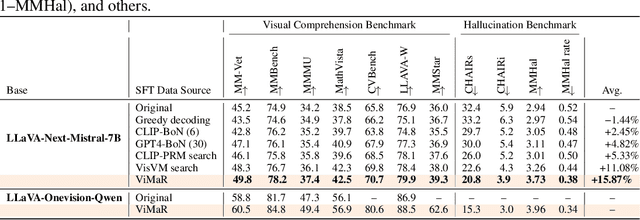

Abstract:Despite significant advances in inference-time search for vision-language models (VLMs), existing approaches remain both computationally expensive and prone to unpenalized, low-confidence generations which often lead to persistent hallucinations. We introduce \textbf{Value-guided Inference with Margin-based Reward (ViMaR)}, a two-stage inference framework that improves both efficiency and output fidelity by combining a temporal-difference value model with a margin-aware reward adjustment. In the first stage, we perform a single pass to identify the highest-value caption among diverse candidates. In the second stage, we selectively refine only those segments that were overlooked or exhibit weak visual grounding, thereby eliminating frequently rewarded evaluations. A calibrated margin-based penalty discourages low-confidence continuations while preserving descriptive richness. Extensive experiments across multiple VLM architectures demonstrate that ViMaR generates captions that are significantly more reliable, factually accurate, detailed, and explanatory, while achieving over 4$\times$ speedup compared to existing value-guided methods. Specifically, we show that ViMaR trained solely on LLaVA Mistral-7B, \textit{generalizes effectively to guide decoding in a stronger unseen model}. To further validate this, we adapt the ViMaR to steer generation in LLaVA-OneVision-Qwen2-7B, leading to consistent improvements in caption quality and demonstrating robust cross-model guidance. This cross-model generalization highlights ViMaR's flexibility and modularity, positioning it as a scalable and transferable inference-time decoding strategy. Furthermore, when ViMaR-generated captions are used for self-training, the underlying models achieve substantial gains across a broad suite of visual comprehension benchmarks, underscoring the potential of fast, accurate, and self-improving VLM pipelines.
RationalVLA: A Rational Vision-Language-Action Model with Dual System
Jun 12, 2025Abstract:A fundamental requirement for real-world robotic deployment is the ability to understand and respond to natural language instructions. Existing language-conditioned manipulation tasks typically assume that instructions are perfectly aligned with the environment. This assumption limits robustness and generalization in realistic scenarios where instructions may be ambiguous, irrelevant, or infeasible. To address this problem, we introduce RAtional MAnipulation (RAMA), a new benchmark that challenges models with both unseen executable instructions and defective ones that should be rejected. In RAMA, we construct a dataset with over 14,000 samples, including diverse defective instructions spanning six dimensions: visual, physical, semantic, motion, safety, and out-of-context. We further propose the Rational Vision-Language-Action model (RationalVLA). It is a dual system for robotic arms that integrates the high-level vision-language model with the low-level manipulation policy by introducing learnable latent space embeddings. This design enables RationalVLA to reason over instructions, reject infeasible commands, and execute manipulation effectively. Experiments demonstrate that RationalVLA outperforms state-of-the-art baselines on RAMA by a 14.5% higher success rate and 0.94 average task length, while maintaining competitive performance on standard manipulation tasks. Real-world trials further validate its effectiveness and robustness in practical applications. Our project page is https://irpn-eai.github.io/rationalvla.
SAM-aware Test-time Adaptation for Universal Medical Image Segmentation
Jun 05, 2025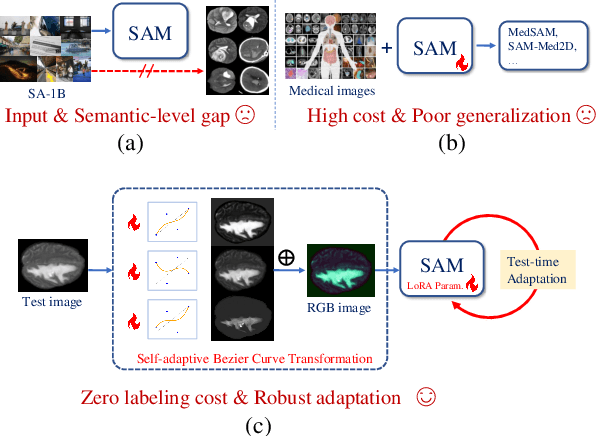
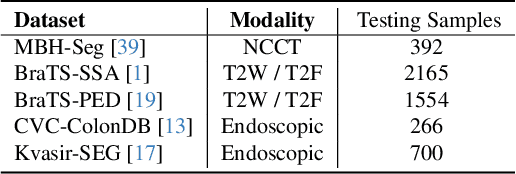
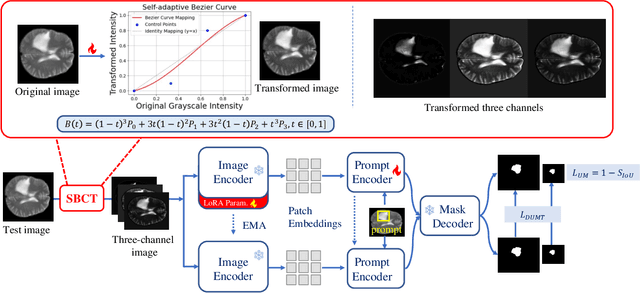

Abstract:Universal medical image segmentation using the Segment Anything Model (SAM) remains challenging due to its limited adaptability to medical domains. Existing adaptations, such as MedSAM, enhance SAM's performance in medical imaging but at the cost of reduced generalization to unseen data. Therefore, in this paper, we propose SAM-aware Test-Time Adaptation (SAM-TTA), a fundamentally different pipeline that preserves the generalization of SAM while improving its segmentation performance in medical imaging via a test-time framework. SAM-TTA tackles two key challenges: (1) input-level discrepancies caused by differences in image acquisition between natural and medical images and (2) semantic-level discrepancies due to fundamental differences in object definition between natural and medical domains (e.g., clear boundaries vs. ambiguous structures). Specifically, our SAM-TTA framework comprises (1) Self-adaptive Bezier Curve-based Transformation (SBCT), which adaptively converts single-channel medical images into three-channel SAM-compatible inputs while maintaining structural integrity, to mitigate the input gap between medical and natural images, and (2) Dual-scale Uncertainty-driven Mean Teacher adaptation (DUMT), which employs consistency learning to align SAM's internal representations to medical semantics, enabling efficient adaptation without auxiliary supervision or expensive retraining. Extensive experiments on five public datasets demonstrate that our SAM-TTA outperforms existing TTA approaches and even surpasses fully fine-tuned models such as MedSAM in certain scenarios, establishing a new paradigm for universal medical image segmentation. Code can be found at https://github.com/JianghaoWu/SAM-TTA.
DeepChest: Dynamic Gradient-Free Task Weighting for Effective Multi-Task Learning in Chest X-ray Classification
May 29, 2025Abstract:While Multi-Task Learning (MTL) offers inherent advantages in complex domains such as medical imaging by enabling shared representation learning, effectively balancing task contributions remains a significant challenge. This paper addresses this critical issue by introducing DeepChest, a novel, computationally efficient and effective dynamic task-weighting framework specifically designed for multi-label chest X-ray (CXR) classification. Unlike existing heuristic or gradient-based methods that often incur substantial overhead, DeepChest leverages a performance-driven weighting mechanism based on effective analysis of task-specific loss trends. Given a network architecture (e.g., ResNet18), our model-agnostic approach adaptively adjusts task importance without requiring gradient access, thereby significantly reducing memory usage and achieving a threefold increase in training speed. It can be easily applied to improve various state-of-the-art methods. Extensive experiments on a large-scale CXR dataset demonstrate that DeepChest not only outperforms state-of-the-art MTL methods by 7% in overall accuracy but also yields substantial reductions in individual task losses, indicating improved generalization and effective mitigation of negative transfer. The efficiency and performance gains of DeepChest pave the way for more practical and robust deployment of deep learning in critical medical diagnostic applications. The code is publicly available at https://github.com/youssefkhalil320/DeepChest-MTL
Towards Dynamic 3D Reconstruction of Hand-Instrument Interaction in Ophthalmic Surgery
May 23, 2025
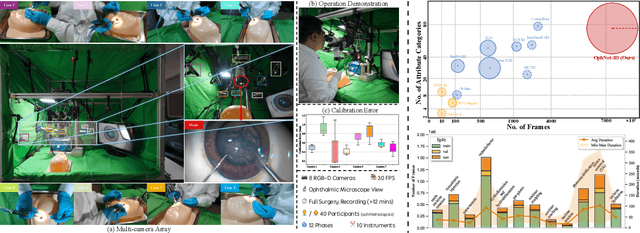
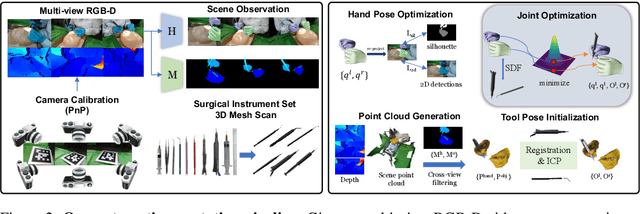
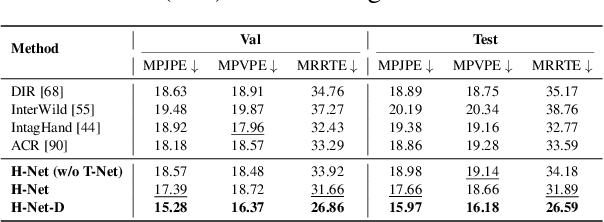
Abstract:Accurate 3D reconstruction of hands and instruments is critical for vision-based analysis of ophthalmic microsurgery, yet progress has been hampered by the lack of realistic, large-scale datasets and reliable annotation tools. In this work, we introduce OphNet-3D, the first extensive RGB-D dynamic 3D reconstruction dataset for ophthalmic surgery, comprising 41 sequences from 40 surgeons and totaling 7.1 million frames, with fine-grained annotations of 12 surgical phases, 10 instrument categories, dense MANO hand meshes, and full 6-DoF instrument poses. To scalably produce high-fidelity labels, we design a multi-stage automatic annotation pipeline that integrates multi-view data observation, data-driven motion prior with cross-view geometric consistency and biomechanical constraints, along with a combination of collision-aware interaction constraints for instrument interactions. Building upon OphNet-3D, we establish two challenging benchmarks-bimanual hand pose estimation and hand-instrument interaction reconstruction-and propose two dedicated architectures: H-Net for dual-hand mesh recovery and OH-Net for joint reconstruction of two-hand-two-instrument interactions. These models leverage a novel spatial reasoning module with weak-perspective camera modeling and collision-aware center-based representation. Both architectures outperform existing methods by substantial margins, achieving improvements of over 2mm in Mean Per Joint Position Error (MPJPE) and up to 23% in ADD-S metrics for hand and instrument reconstruction, respectively.
 Add to Chrome
Add to Chrome Add to Firefox
Add to Firefox Add to Edge
Add to Edge